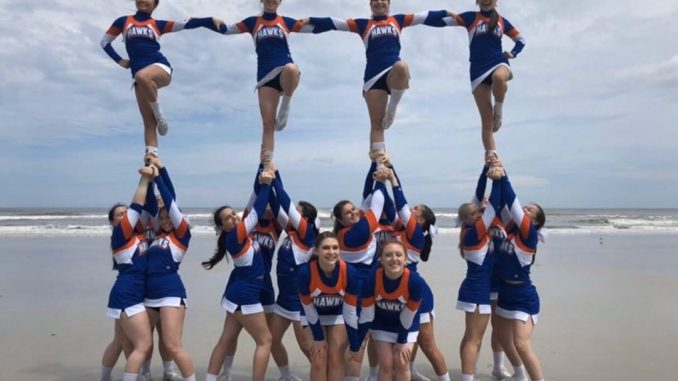
Stay tight! Squeeze! Pull! These are expressions that every cheerleader becomes familiar with throughout their seasons, yet many other athletes have no clue what they mean.
American cheerleading made its first appearance in 1869 during a Princeton University and Rutgers University football game. In 1923 women were allowed to cheer for the first time, and that’s also when cheer incorporated tumbling into their routine. By the late ’80s and early ’90s, All-Star cheerleading grew rapidly.
All-Star cheerleading focuses on extreme training and practice of a routine in order to compete against other teams. A typical competitive routine is no longer than two minutes and 30 seconds. Routines consist of tumbling, jumps, main stunt, pyramid (wall) and dance.
Each stunt group typically consists of four cheerleaders. The person on top is referred to as the flyer, they are the one that gets thrown around. Each group has two bases, a main base and side base. The primary job of the bases is to hold the flyer and lift them up. Finally, the backspot typically stands behind the flyer and grips their ankles and calf; they are the main people that catch the flyer when they fall.
The main stunt can be considered the most important part of a routine. This is when the team strives to show everything they are made of. It usually is the most difficult part of the routine, where multiple stunt groups try to hit a set of skills in unison. The pyramid is when all stunt groups come together and brace on to each other to perform even more skills, such as flips.
Tumbling, to some, is the heart of cheerleading. It is the floor aspect of gymnastics, and cheerleaders have to work at it weekly, if not daily. Many spend grueling hours in the gym or with an instructor working the muscles and flexibility needed. A roundoff back handspring, for example, is one skill that requires extensive knowledge and practice. The tumbler must set up their roundoff correctly, and if a component is missing (such as your hands being ever so slightly dispositioned), then their back handspring could crumble.
Other tumbling passes may include roundoff back handspring, back tuck, standing tuck, layout or front bounder. It is one thing to put in the work to master these passes, but it is another to actually work up the nerve to do it on a mat with no springs. Tumblers must throw caution to the wind and trust that they put in enough time to master the skills.
Cheerleading across the board in college is not a sport, no matter what school you go to. Why is that? It’s true that cheerleaders will be found at football and basketball games with their peppy smiles and spunky attitudes, but it does not end there. Even though club cheerleaders compete at the national level, not many are willing to look past the traditional image of cheerleaders.
So the real question is, how does a sport qualify as a sport? The actual definition of a sport is “an activity involving physical exertion and skill in which an individual or team competes against another or others for entertainment.” That right there would prove cheer is a sport, but let’s further examine the components of fitness. Agility? Yes, bases often switch their positions while their flyer is in motion. Balance? Seriously? Cheer is all about balance. Coordination? The stunt group wouldn’t survive without it. Power? Totally, a lot of energy is exerted in a short period of time. Reaction time? Necessary in order to catch your flyer if something goes wrong. Speed? A basic component of tumbling. It would be difficult to form a strong argument against cheer being a sport.
If all of this is true, then why is cheer stuck in the category of a club? At New Paltz, the cheerleaders practice their competitive routine three days a week throughout the year for several hours a day, and they even have early morning practices like other sports at New Paltz.
First-year flyer Alexia Jablesnik has been cheering for seven years. She explained that this year the team is competing at Nationals in Daytona, Florida this upcoming Easter weekend. She said that the budget the school gives the team isn’t even enough to pay for their trip and competition at Nationals.
“I think my whole team would agree that only being a club sport prevents us from doing a lot of things,” Jablesnik said. “We had to fundraise to buy our uniforms ourselves, among other things that are required for the team.”
Jablesnik also added the team works very hard, gets along very well and that she hopes that they place at Nationals.
Next time you’re at a basketball game and watching the cheerleaders, try to think about all the variables that go into this sport, whether New Paltz considers it one or not. After all, isn’t it only right that their hard work should be recognized and acknowledged?

